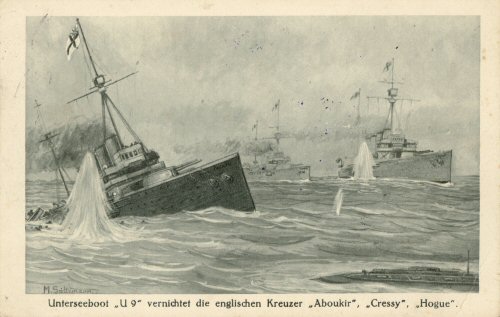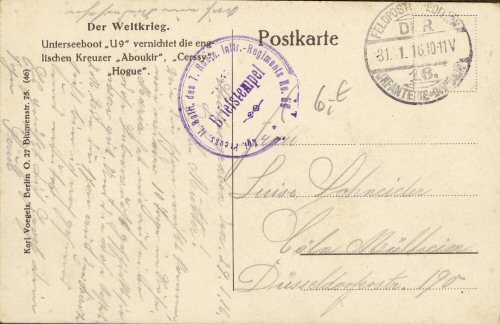
U3-class submarine. L/B/D: 188.3 × 19.7 × 10.2 (57.4m × 6m × 3.1m). Tons: 493/611 disp. Hull: steel. Comp.: 29. Arm.: 4 × 18TT; 3.7cm mg. Mach.: gasoline engines, 1,160 ehp; 14.2/8.1 kts. Built: Kaiserlich Werft, Danzig, Germany; 1910.
Under Lieutenant Otto Weddigen, U-9 took part in German fleet maneuvers in 1912 during which she was credited with "sinking" three battleships. During the uneasy days after the assassination of Austrian Archduke Francis Ferdinand, U-9 was the first submarine to attempt reloading torpedo tubes from a submerged position. One of the first German submarines on patrol during World War I, in September U-9 rode out a two-day storm off the coast of the Netherlands. Surfacing again on the morning of the 22nd, the crew were "agreeably surprised," wrote Lieutenant Commander Johann Spiess, Weddigen's second-in-command. "The light streamed up from the eastern horizon and spread over a cloudless sky.... A fine day to sink a ship."
Shortly thereafter, smoke was seen on the horizon, and U-9 submerged. Three cruisers soon came into view and, closing to a distance of only 500 yards from the cruiser Aboukir, Cressy and Hogue, Weddigen fired one torpedo at 0720. Assuming that their sister ship had struck a mine, HMS Cressy and HMS Hogue (see Aboukir, Cressy and Hogue) closed to pick up survivors. Half an hour later, U-9 fired two torpedoes into Hogue, only 300 yards away. Turning on her axis, U-9 fired her two stern torpedoes at Cressy, one of which missed, then turned again and fired her last torpedo. In addition to the three out-dated cruisers—First Lord of the Admiralty Winston Churchill had referred to the Bacchante-class cruisers as "live bait"—the Royal Navy lost 1,459 experienced crew. Weddigen and his crew were awarded Germany's highest honor, the Pour le Mérite.
A scant three weeks later, U-9 sailed again from Wilhelmshaven to the Royal Navy's base at Scapa Flow. On October 15, U-9 came across the cruisers HMS Hawke and Endymion in the North Sea. Again at a range of only 500 yards, Weddigen fired one torpedo into Hawke, which sunk eight minutes later with the loss of 544 of her crew; there were 52 survivors. A subsequent attack on a line of destroyers—the submarine's chief enemy—nearly ended in disaster for U-9, and the boat achieved sufficient depth to avoid ramming with just seconds to spare.
Outmoded by 1916, U-9 was restricted to training duty until surrendered to the Allies on November 26, 1918. She was taken to England and broken up in 1919.
